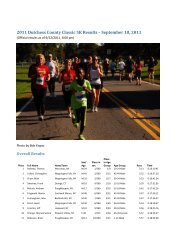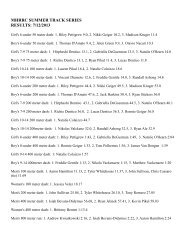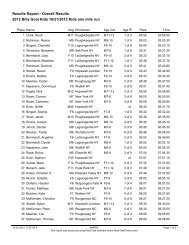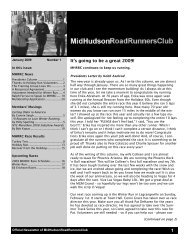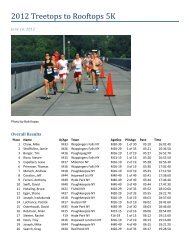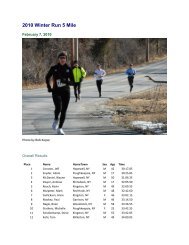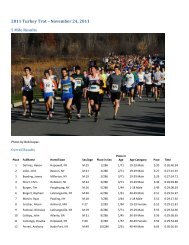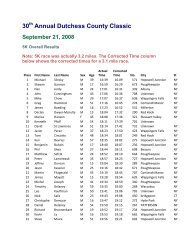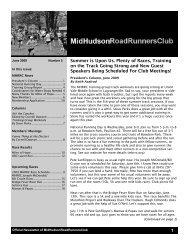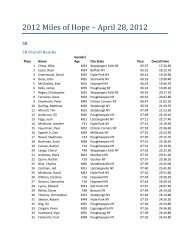1 Great Turnout at Recent Club Races! - Mid-Hudson Road Runners
1 Great Turnout at Recent Club Races! - Mid-Hudson Road Runners
1 Great Turnout at Recent Club Races! - Mid-Hudson Road Runners
Create successful ePaper yourself
Turn your PDF publications into a flip-book with our unique Google optimized e-Paper software.
ColumnsAsk the CoachesEdited by Cornell DawsonQuestion:I am a working mother of toddler twins with littletime for myself. I am thinking of starting runningbecause of all the advantages (I can go when I have abreak, little equipment needed, no driving to exercise).Kevin Dollard:By walking out the door … just do it!Steve Perks:From the N<strong>at</strong>ional Running Day site,www.runningday.org.―It’s easy to get started running. Here are some simpleguidelines everyone can follow to safely andpleasurably develop their ability to run.4Relax. Running is a n<strong>at</strong>ural act, like bre<strong>at</strong>hing orwalking. Just about anyone can do it. It is, however,recommended th<strong>at</strong> you consult a healthprofessional before undertaking a serious trainingprogram. You may wish to start by walkingfirst, and then gradually incorpor<strong>at</strong>ing runninginto your training program.Think positively. Don’t be discouraged. If you canget through the first several weeks of training,you will find th<strong>at</strong> wh<strong>at</strong> seems like a big effort <strong>at</strong>the start will soon feel n<strong>at</strong>ural and easy to you.Within a few weeks, you will experience the purejoy of running down the street or along a parkp<strong>at</strong>h.Buy quality gear. The only equipment you willneed is comfortable exercise clothes and goodrunning shoes. Go to a running specialty storeand get advice about the right shoes for you. Youcan get good running shoes for $80-120.Train with a plan. Choose a running/walkingcourse th<strong>at</strong> is readily accessible to you. Duringyour first two training weeks, try to run two orthree times per week, on altern<strong>at</strong>e days. Whenyou feel ready, increase to four days a week, thenfive days. The idea is to build up gradually. Eventop competitive runners take days off regularly torest and avoid injury. Stretch your muscles onboth your running and non-running days.It’s okay to walk. Begin your first workouts with15 minutes of altern<strong>at</strong>ing walking and jogging:Walk for five minutes, then run easily for two orthree minutes; repe<strong>at</strong>. If you are comfortable joggingfrom the start, th<strong>at</strong>’s fine, but do not run theentire time even if you think you can. Don’t worryabout the distance you cover. On your third orfourth workout, try increasing your time to 20minutes. After three or four more workouts, moveto 25 minutes, then after another three or fourworkouts, try a 30-minute continuous run. Don’tforce yourself to go farther or faster than wh<strong>at</strong>feels comfortable to you. The idea is to keep runningregularly, and you’re more likely to do th<strong>at</strong> ifyou’re enjoying yourself and looking forward toyour next run.Run <strong>at</strong> ―convers<strong>at</strong>ion‖ pace. If you can’t ch<strong>at</strong> withyour running companions, you are going too fast.If you are running alone, try singing to yourself,out loud, to make sure your effort and bre<strong>at</strong>hingare under control. If you can’t sing, slow down.‖Question:How do I progress?Kevin Dollard:Keep walking out the door. Have fun with it. Mix it upa bit. Find others to meet you. Set a race goal. Try and<strong>at</strong>tend our MHRRC Tuesday evening track practices.Steve Perks:The N<strong>at</strong>ional Running Day site, www.runningday.org,continued.If your schedule allows, include cross training.Biking, elliptical training, and lifting light weightscan help strengthen non-running muscles and preventinjury. Swimming and deep w<strong>at</strong>er runningcan also be helpful in balancing your training andavoiding injuries.Aim for a race. Pick an event th<strong>at</strong>’s <strong>at</strong> least sixweeks in the future. An ideal distance for yourfirst race would be 5K (3.1 miles) or four miles.This is short enough so th<strong>at</strong> you can truly beready for your first effort, and long enough to giveyou the sense of accomplishment th<strong>at</strong> will fuelyour future running. Your goal should be to finish,enjoy the event, and look ahead. Start <strong>at</strong> the backof the pack, hold yourself back <strong>at</strong> the start, andrun within your comfort range. If your time wasslow, th<strong>at</strong>’s good—now you have a base fromwhich to improve.For your next race, try a few short speed workouts.After a mile warm-up, run a series of faster(Continued on page 5)Visit us on the web <strong>at</strong>: www.mhrrc.org




